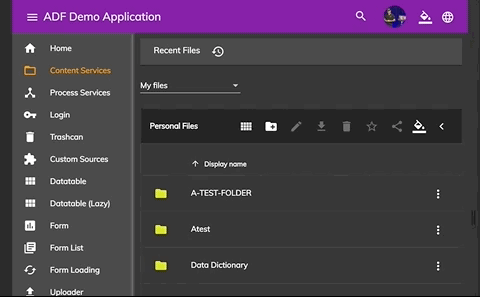How To Add The New Sidenav Layout Component In Your ADF App
- Alfresco Hub
- :
- ADF - Forum
- :
- How To Add The New Sidenav Layout Component In You...
How To Add The New Sidenav Layout Component In Your ADF App
- Subscribe to RSS Feed
- Mark as New
- Mark as Read
- Bookmark
- Subscribe
- Printer Friendly Page
- Report Inappropriate Content
SIn the version 2.3.0 of ADF has been added a new Sidenav Layout Component :

In the next version of the generator this component will be by default present in your new generated app, but what if you want to add it to your current application?
In this tutorial, we are going to add this new component in a previous version of an ADF application. If you need more details about the sidenav layout component after the tutorial please check the documentation:
If you want to give a look at the example that I made, you can find it here:
Dev eromano sidebar by eromano · Pull Request #23 · Alfresco/adf-examples · GitHub
Step 1
Update your current application package.json ADF dependencies to 2.3.0:
"@alfresco/adf-content-services" : "2.3.0"
"@alfresco/adf-process-services" : "2.3.0"
"@alfresco/adf-core" : "2.3.0"
"@alfresco/adf-insights" : "2.3.0"
"alfresco-js-api": "2.3.0"
Step 2
Generate the app-layout component:
ng generate component app-layoutModify app-layout.component.html
Note the route and the element in the HTML below are just for example, you need to feed this template with your own routes and elements:
<adf-sidenav-layout [sidenavMin]="70" [sidenavMax]="200" [stepOver]="780" [hideSidenav]="false" [expandedSidenav]="false">
<adf-sidenav-layout-header>
<ng-template let-toggleMenu="toggleMenu">
<mat-toolbar color="primary" class="adf-app-layout-toolbar mat-elevation-z6">
<button mat-icon-button (click)="toggleMenu()">
<mat-icon>menu</mat-icon>
</button>
<span fxFlex="1 1 auto" fxShow fxHide.lt-sm="true">ADF</span>
<div class="adf-app-layout-menu-spacer"></div>
</mat-toolbar>
</ng-template>
</adf-sidenav-layout-header>
<adf-sidenav-layout-navigation>
<ng-template let-isMenuMinimized="isMenuMinimized">
<mat-nav-list class="adf-sidenav-linklist">
<a mat-list-item class="adf-sidenav-link" routerLink="/login">
<mat-icon matListIcon class="sidenav-menu-icon">vpn_key</mat-icon>
<div class="sidenav-menu-label" *ngIf="!isMenuMinimized()">Login</div>
</a>
<a mat-list-item class="adf-sidenav-link" routerLink="/apps">
<mat-icon matListIcon class="sidenav-menu-icon">device_hub</mat-icon>
<div class="sidenav-menu-label" *ngIf="!isMenuMinimized()">Apps</div>
</a>
<a mat-list-item class="adf-sidenav-link" routerLink="/documentlist">
<mat-icon matListIcon class="sidenav-menu-icon">folder_open</mat-icon>
<div class="sidenav-menu-label" *ngIf="!isMenuMinimized()">Documents</div>
</a>
<a mat-list-item adf-logout class="adf-sidenav-link">
<mat-icon matListIcon class="sidenav-menu-icon">exit_to_app</mat-icon>
<div class="sidenav-menu-label" *ngIf="!isMenuMinimized()">Logout</div>
</a>
</mat-nav-list>
</ng-template>
</adf-sidenav-layout-navigation>
<adf-sidenav-layout-content>
<ng-template>
<router-outlet></router-outlet>
</ng-template>
</adf-sidenav-layout-content>
</adf-sidenav-layout>Modify app-layout.component.scss
In this SCSS file should be present only the router outlet
adf-sidenav-layout {
height: 100%;
}Modify app.component.html
In this HTML file should be present only the router outlet
<router-outlet></router-outlet> Step 3
Modify app.routes.ts
Now let's add the AppLayoutComponent as the main route of the router and move all yours previous route as children of the AppLayoutComponent as in this example:
export const appRoutes: Routes = [
{
path: '',
component: AppLayoutComponent,
children: [
{
path: '',
component: HomeComponent
},
{.....},
{.....},
{.....},
{.....},
{.....}
]
};If you have more questions, please reply here or contact me using gitter .
You must be a registered user to add a comment. If you've already registered, sign in. Otherwise, register and sign in.
Blog posts and updates about Application Development Framework (ADF).
- Extending the Alfresco Digital Workspace (ADW)
- Developing Take Ownership Extension for ACA 2.8.0
- Creating your first extension for Alfresco Content...
- ADF 4.0.0 is out!
- Hey Front-End Developer, what are your preferred o...
- We want to (thank and) reward our ADF contributors...
- How to update ADF from version 2.5.0 to 2.6.1
- Application Development Framework (ADF) 2.6.1 Rele...
- ADF 2.6.0 Release Note
- How to update ADF from version 2.4.0 to 2.5.0
- ADF 2.5.0 Release Note
- ADF 2.4.0 Release Note
- How to deploy an ADF APP
- How To Add The New Sidenav Layout Component In You...
- How to integrate ADF log service with Mixpanel an...
We use cookies on this site to enhance your user experience
By using this site, you are agreeing to allow us to collect and use cookies as outlined in Alfresco’s Cookie Statement and Terms of Use (and you have a legitimate interest in Alfresco and our products, authorizing us to contact you in such methods). If you are not ok with these terms, please do not use this website.
